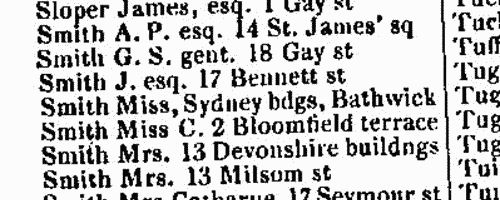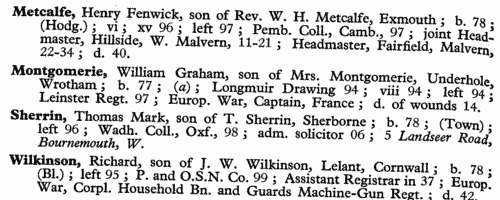Add this eBook to your basket to receive access to all 59 records. Our indexes include entries for the spelling allford. In the period you have requested, we have the following 59 records (displaying 21 to 30): These sample scans are from the original record. You will get scans of the full pages or articles where the surname you searched for has been found. Your web browser may prevent the sample windows from opening; in this case please change your browser settings to allow pop-up windows from this site.  Clerks and apprentices
(1787) Clerks and apprentices
(1787)
Apprenticeship indentures and clerks' articles were subject to a 6d or 12d per pound stamp duty: the registers of the payments usually give the master's trade, address, and occupation, and the apprentice's name, as well as details of the date and length of the apprenticeship. 2 January to 31 December 1787. IR 1/33 | Sample scan, click to enlarge

| Inhabitants of Axbridge in Somerset
(1790-1797)
The provincial sections of the Universal British Directory include lists of gentry and traders from each town and the surrounding countryside, with names of local surgeons, lawyers, postmasters, carriers, &c. (the sample scan here is from the section for Bath). The directory started publication in 1791, but was not completed for some years, and the provincial lists, sent in by local agents, can date back as early as 1790 and as late as 1797.
| Sample scan, click to enlarge

|  Apprentices and clerks
(1804) Apprentices and clerks
(1804)
Apprenticeship indentures and clerks' articles were subject to a 6d or 12d per pound stamp duty: the registers of the payments usually give the master's trade, address, and occupation, and the apprentice's name, as well as details of the date and length of the apprenticeship. 2 January to 31 December 1804. IR 1/39 | Sample scan, click to enlarge

| Government officers and officials
(1805)
Many of the main government offices, almost all in London, are covered by these lists from Holden's Triennial Directory of 1805 to 1807 - Receipt of His Majesty's Exchequer and Exchequer Bill Pay Office in Old Palace Yard; First Annuity Office; Second Annuity Office; Examiners of Tellers Vouchers Department; Pell's Office, Old Annuity and Tontine; Tellers of Receipts; Tally Office; Exchequer Bill Pay Office in New Palace Yard; the Board of Commissioners for the Affairs in India, in Whitehall; Lord Commissioners for Trade and Foreign Plantations, in Whitehall; Board of Works, in Scotland Yard; Barrack Office, in Spring Gardens; Officers of the Tower; the Land Tax Redemption Office, in Parliament Street; the Land Tax Register Office, in Lincoln's Inn Fields; the St Domingo Board, at Poet's Corner; the Queen Anne's Bounty Office, in Dean's Yard, Westminster; the King's Stationery Office, in Palace Yard; the Stamp Office, at Somerset House; the Tax Office there; the Office for Sick and Wounded Seamen, also there; the Hawkers' and Pedlars' Office in Somerset Place; the Hackney Coach Office at Somerset House; the Lord Treasurer's Remembrancer's Office; the Pipe Office, in Somerset Place; the Signet Office, at Somerset House; the Privy Seal Office, there; the Duchy Court of Lancaster, also there; the Transport Office at Dorset Square (which included the staff dealing with prisoners-of-war); and the Office of the County Palatine of Lancaster. | Sample scan, click to enlarge

| Staffordshire Villages Directory: Bradeley
(1818)
The Staffordshire General and Commercial Directory was published by W. Parson and T. Bradshaw in 1818 in thirty sections for the major towns, followed by lists for the separate villages. In each village the traders are listed alphabetically under surname, with occupation. | Sample scan, click to enlarge

| Inhabitants of Dorset
(1830)
Pigot & Co.'s National Commercial Directory lists traders, farmers and private residents in the county. | Sample scan, click to enlarge

| Inhabitants of Somerset
(1830)
Pigot & Co.'s National Commercial Directory lists traders, farmers and private residents in the county. | Sample scan, click to enlarge

| Inhabitants of Wiltshire
(1830)
Pigot & Co.'s National Commercial Directory lists traders, farmers and private residents in the county. | Sample scan, click to enlarge

| Boys entering Sherborne School
(1823-1835)
The grammar school at Sherborne in Dorset, which doubtless existed from the creation of the diocese of Sherborne in 705, was refounded by king Edward VI in 1550. At the quatercentenary in 1950, a fourth edition of the Sherborne Register was published, listing boys entering the school during those four centuries. In truth, the materials for this register survive but fitfully before 1823; for some years, no names are known; sometimes all that is known is a surname. But from 1823 onwards the lists and the details get steadily more comprehensive. By the 20th century the boys are listed alphabetically by surname under term of entrance. Surname is given in bold, then christian names, name of father (surname and initials) and address; year of birth; house (a, School House; b, Abbey House; c, The Green; d, Harper House (formerly The Retreat); f, Abbeylands; g, Lyon House; h, Westcott House); whether represented the school at cricket (xi), football (xv), shooting (viii), &c.; year of leaving; summary of degrees, career &c.; and (in italics), address as of 1950. Names in the early lists marked with an asterisk are found inscribed on the oak panelling or on the stone walls of the former schoolroom. (F) in the lists indicates a foundationer, receiving free education: after 1827, when this privilege was restricted to boys from Sherborne and neighbourhood, nearly all foundationers were day-boys. | Sample scan, click to enlarge

| Insolvents
(1836)
Insolvency notices for England and Wales: insolvency often caused people to restart their lives elsewhere, so these are an important source for lost links | Sample scan, click to enlarge

|
Research your ancestry, family history, genealogy and one-name study by direct access to original records and archives indexed by surname.
|












